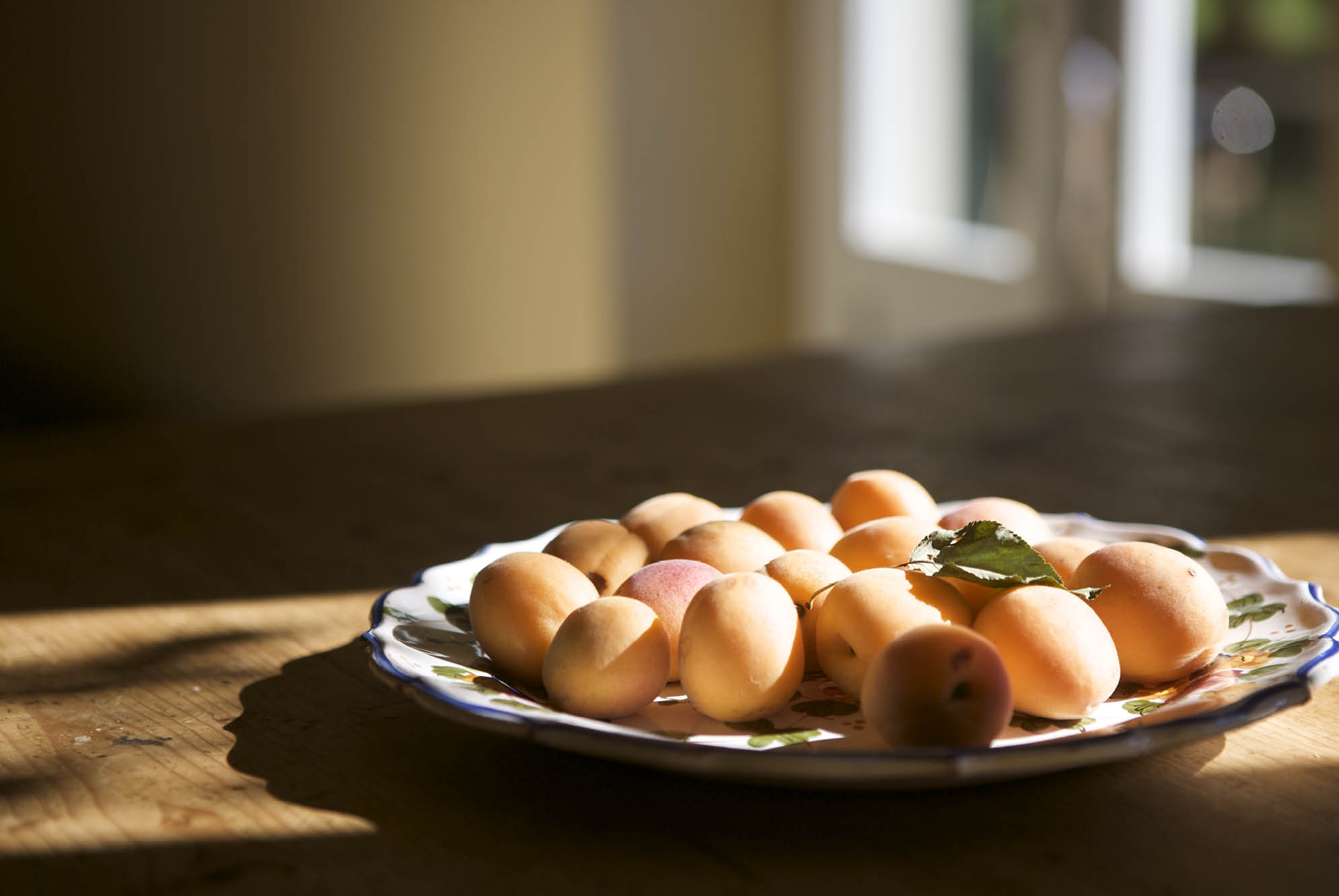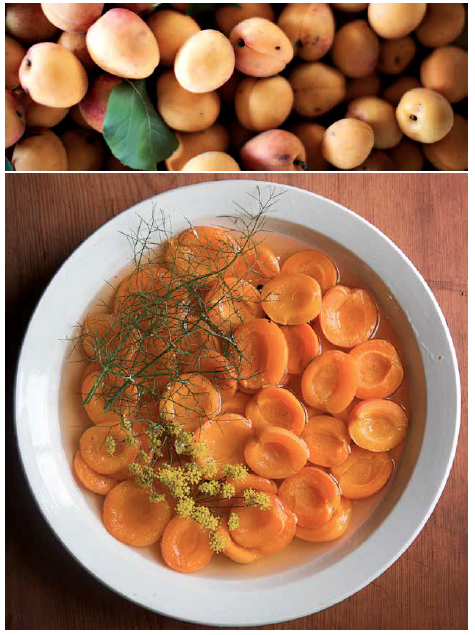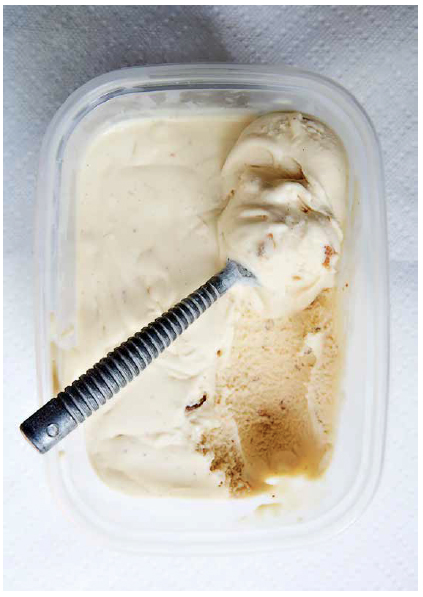

dolci

WINE-POACHED APRICOTS WITH RICOTTA
serves 6
We planted bronze fennel (Foeniculum vulgare ‘Purpureum’), which is a culinary herb, in our garden a few years ago and it took off. Each spring it comes back fuller and more vigorous than the year before. By midsummer, the tall feathery plants are blooming lacy yellow flowers (which eventually bear the tiny aromatic seeds we cook with), just as the apricots appear at our local orchard. We love the combination of these two flavors: the perfumed apricots and licorice of the fennel. We keep some of the flavorful syrup from the apricots to make a refreshing drink with bubbly prosecco, or with sparkling water over ice.
FOR THE APRICOTS
1 bottle white wine
1½ cups sugar
4 branches fennel fronds, preferably with their flowering heads
6 black peppercorns
1½ pounds apricots, halved and pitted
FOR THE RICOTTA
2 cups finest fresh ricotta
1 tablespoon sugar
For the apricots, put the wine and sugar into a heavy, wide pot. Bring to a simmer over medium heat, stirring often, until the sugar dissolves. Add the fennel fronds, peppercorns, and apricots to the hot syrup. Simmer until the fruit has softened but still holds its shape, 2–3 minutes. Remove the pot from the heat. Let the apricots cool in the syrup, stirring gently from time to time. Discard the fennel fronds and peppercorns. The apricots will keep in their syrup in the refrigerator for up to 5 days.
For the ricotta, using a wooden spoon, mix together the ricotta and sugar in a medium bowl until well blended. Keep refrigerated until ready to serve. To serve, divide the ricotta between 6 dessert dishes and spoon some of the apricots and their syrup over them.

RASPBERRY TART WITH MASCARPONE CREAM
makes one 11-inch tart
This elegant tart with its buttery, almond-flecked crust is good any time of year, but made with juicy raspberries in season, it’s really good!
FOR THE CRUST
1½ cups all-purpose flour
½ cup almond meal or almond flour
¼ cup sugar
1 teaspoon salt
8 tablespoons cold unsalted butter
1 whole egg
1 egg yolk
1 tablespoon white wine
FOR THE FILLING AND CREAM
½ cup seedless raspberry jam
2 pints (4–5 cups) fresh raspberries
3 tablespoons superfine sugar
1½ cups mascarpone
Finely grated zest of 1 small orange
1 tablespoon kirsch
For the crust, whisk the flour, almond meal, sugar, and salt together in a large mixing bowl. Cut the butter into the flour mixture using a pastry blender or 2 butter knives until it resembles wet sand. Lightly beat the egg and egg yolk together with the wine in a small bowl. Stir the egg mixture into the flour mixture with a fork. Press the dough together until it forms a rough ball. Try not to overhandle the dough or the crust will be tough. Shape the dough into a flat disk, wrap in plastic wrap, and refrigerate for at least 1 hour. Roll out the dough on a lightly floured surface into a thin 13-inch round. Roll the dough around the rolling pin, then unfurl it into an 11-inch fluted tart pan with removable bottom. Trim off any excess dough and crimp the edges. Prick the dough with a fork, then refrigerate for 30 minutes.
Preheat the oven to 375°. Line the crust with parchment paper or foil and fill with pie weights. Bake until pale brown, 20 minutes. Remove the parchment paper and pie weights from the crust and bake until the crust is golden brown, about 20 minutes. Transfer to a wire rack to cool slightly. For the filling and cream, spread the jam over the bottom of the warm crust. Arrange the berries in a single layer on top of the jam. Sprinkle the tart with 1 tablespoon of the sugar. Combine the mascarpone, orange zest, remaining 2 tablespoons sugar, and kirsch in a mixing bowl. Serve the tart with the cream.

FIG GELATO
makes 1 quart
We have several fledgling fig trees that bear beautiful leaves and, if we’re lucky, a handful of fruit. Fig country we do not live in! But we love their jammy sweetness so we make this exquisite gelato with preserves. As we eat it, we close our eyes and pretend that the rich fig flavor came from our very own figs from our very own trees.
2 cups whole milk
1 cup heavy cream
¾ cup sugar
6 egg yolks
Pinch of salt
1 cup fig preserves
2 teaspoons vanilla bean paste or vanilla extract
Put the milk, cream, and ½ cup of the sugar into a heavy saucepan and bring to a simmer over medium heat, stirring gently until the sugar dissolves. Meanwhile, put the egg yolks, salt, and the remaining ¼ cup of sugar into a medium mixing bowl and whisk together until the yolks are thick and pale yellow. Gradually ladle about 1 cup of the hot milk into the yolks, whisking constantly. Stir the warm yolk mixture into the hot milk in the saucepan. Reduce the heat to low and cook, stirring constantly, until the custard is thick enough to coat the back of the spoon and registers between 175° and 180° on an instant-read thermometer, about 10 minutes. Stirring the custard constantly as it cooks and thickens prevents it from coming to a boil and curdling.
Strain the custard into a medium bowl. Stir in the fig preserves and vanilla. Set the bowl into a larger bowl filled with ice, then stir the custard frequently until it has cooled. Cover the custard and refrigerate it until completely chilled, about 4 hours (it can keep in the refrigerator for up to 2 days).
Churn the custard in an ice-cream maker following the manufacturer’s instructions. Scoop the gelato (it will have the consistency of soft-serve) into a quart container with a lid, cover, and freeze for a couple of hours until it is just firm. If you serve the gelato after it is frozen solid, let it soften before serving. It will keep for up to 2 days in the freezer.
ALMOND MILK ICE CREAM
makes about 1 quart
We like our ice cream rich, yet this one, despite lacking eggs or heavy cream, is a favorite. It’s smooth and full of flavor, but lighter and more refreshing than a custard-based ice cream. When we are pressed for time, or are feeling lazy (God forbid!), we make the quick version of this recipe provided below.
1½ cups whole almonds
4 cups whole milk
1 cup sugar
2 tablespoons honey
Put the almonds in a food processor and pulse until they are finely ground, being careful not to grind them to a paste. Set aside. Put the milk and sugar into a heavy medium saucepan. Heat over medium heat, stirring frequently, until the sugar dissolves and the milk is hot. Take care not to let the milk come to a boil. Remove the pan from the heat and stir the ground almonds into the hot milk. Set it aside to cool. Transfer to a bowl, cover with plastic wrap, and refrigerate overnight.
Line a medium sieve with a large double-thick layer of cheesecloth and set the sieve over a deep bowl. Pour the almonds and milk through the cheesecloth. Gather up the ends and wring out as much of the milk as possible into the bowl. Discard the nuts. Stir the honey into the milk.
Churn the almond milk in an ice-cream maker following the manufacturer’s directions. Scoop the ice cream into a quart container with a lid, cover, and freeze until just firm. The ice cream will keep for up to 3 days in the freezer.
QUICK ALMOND MILK ICE CREAM
Combine 4 cups unsweetened almond milk, 1 cup superfine sugar, 2 tablespoons honey, and ¼ teaspoon almond extract in a large mixing bowl, stirring until the sugar dissolves. Cover with plastic wrap and refrigerate until well chilled, about 4 hours. Churn the almond milk in an ice-cream maker following the manufacturer’s directions. Scoop the ice cream into a quart container with a lid, cover, and freeze until just firm. The ice cream will keep for up to 3 days in the freezer.—makes about 1 quart

Almond “Cookie” tart
ALMOND COOKIES
makes about 20
The recipe for these cookies is based on the classic Sienese ricciarelli, a staple of the dessert table at Christmas. In the summer, we serve them with ripe cherries, peaches, and apricots. And year-round we dip these delicate cookies into our cups of our afternoon espresso.
2 cups whole blanched almonds
¾ cup sugar
Finely grated zest of 1 orange
Finely grated zest of 1 lemon
1 teaspoon vanilla extract
½ teaspoon almond extract
2 egg whites
Pinch of cream of tartar
Preheat the oven to 325°. Put the almonds and ½ cup of the sugar in a food processor and pulse until the almonds are finely ground, being careful not to grind them to a paste. Add the citrus zests and the extracts and pulse a few times to combine. Transfer the ground almonds to a large mixing bowl. Whisk the egg whites and cream of tartar together in a medium mixing bowl until they hold soft peaks. Gradually add the remaining ¼ cup sugar, whisking constantly, until the whites hold stiff but not dry peaks. Gently fold the egg whites into the ground almonds. The dough will be soft and moist. Using two smallish soup spoons, shape the dough into small quenelles or ovoids, arranging them at least 1 inch apart on cookie sheets lined with parchment paper. Bake the cookies until puffed and pale golden brown, about 20 minutes. Remove the cookies from the oven and when cool enough to handle, peel them off the paper and transfer them to a wire rack to cool completely.
VARIATION: To make one large “cookie” tart, spread the almond cookie dough into an ungreased 9-inch fluted tart pan with a removable bottom and smooth out the top. Press about ⅓ cup blanched almonds decoratively around the edge of the dough, if you like. Scatter ½ cup sliced almonds over the center of the dough, gently pressing them in. Bake until puffed and pale golden brown, about 30 minutes. Loosen the cookie from the sides of the tart pan while still warm, then transfer it to a wire rack to cool. To serve, cut into wedges or break into roughly shaped pieces and serve dusted with powdered sugar, if you like.

Top to bottom: Almond Cookies, Zaletti, and Biscotti di Anice
BISCOTTI DI ANICE
makes about 4 dozen cookies
We grew up adoring those Stella D’oro aniseed biscuits, long before biscotti (a word most Americans had never even heard of back then) became the rage. These fine biscotti remind us of those biscuits, and taste even better.
2 cups plus 1 tablespoon all-purpose flour
½ teaspoon baking powder
½ teaspoon baking soda
3 large eggs
¾ cup plus 1 tablespoon sugar
½ teaspoon vanilla bean paste or vanilla extract
1 heaping tablespoon aniseeds
Preheat the oven to 350°. Whisk together the flour, baking powder, and baking soda in a medium bowl and set aside. Beat together the eggs, sugar, and vanilla bean paste in the bowl of a standing mixer with the whisk attachment on medium speed until thick and pale yellow (it should fall from the whisk in a wide ribbon), 8–10 minutes.
Remove the bowl from the mixer. Fold the flour mixture into the egg mixture in three batches with a rubber spatula, folding after each addition until just combined. Fold in the aniseeds. The dough will be very sticky. Line two baking sheets with parchment paper. Using floured hands, shape the dough into four 5 × 2-inch logs on the baking sheets. Leave at least 2 inches between the logs; the dough will rise considerably as it bakes.
Bake until the logs are pale golden brown, about 20 minutes, rotating the baking sheets halfway through. Remove the logs from the oven and let them cool on the baking sheets for a few minutes. Reduce the oven temperature to 300°.
Using a serrated knife, cut the warm logs crosswise into ½-inch-thick biscotti. Place them cut side up in a single layer on the baking sheets. Bake for 5 minutes, then turn them over and bake until pale golden brown, about 5 minutes. Remove the biscotti from the oven and transfer them to wire racks to cool completely. They will keep in an airtight container for up to 2 weeks.
ZALETTI
makes about 40 cookies
We like to use medium stone-ground cornmeal for these currant-studded cookies. If you prefer a finer crunch, you can use finely ground cornmeal. This versatile dough can also be rolled out with a rolling pin and cut into small, dainty circles.
1 cup dried currants
¼ cup dark rum
1 cup plus 2 tablespoons stoneground cornmeal
1¼ cups all-purpose flour, plus more for dusting
½ teaspoon baking soda
½ teaspoon baking powder
½ teaspoon salt
4 large egg yolks
½ cup sugar
6 tablespoons melted, unsalted butter, cooled
Finely grated zest of 2 lemons
Preheat the oven to 350°. Soak the currants in the rum in a small bowl until plump. Meanwhile, whisk together the cornmeal, flour, baking soda, baking powder, and salt in a medium mixing bowl and set aside.
Beat the egg yolks in the bowl of a standing mixer with the paddle attachment on medium speed. Gradually add the sugar, beating until thick and pale yellow. Beat in the melted butter and lemon zest, beating until smooth. Gradually add the cornmeal mixture, beating until well combined. The dough should be firm; if it is too dry, beat in some of the rum from the currants, 1 tablespoon at time, to soften it. Remove the bowl from the mixer. Drain the currants completely and stir them into the dough.
Lightly flour a work surface. Divide the dough in half and shape each half into two 2-inch square logs about 10 inches long. Brush off any excess flour from the logs, then cut them into ½-inch-thick pieces. Gently press each cookie into a diamond shape.
Line the baking sheets with parchment paper. Arrange the cookies on the sheets and bake until golden and crisp, 15–20 minutes. Remove the cookies from the oven and when cool enough to handle, peel them off the paper and transfer to a wire rack to cool completely. They will keep in an airtight container for up to 2 weeks.